May 13th, 2013
 The Global Women’s Leadership Network has joined forces with others to launch a major effort in developing women and girl leaders around the world. They posted an open innovation challenge and are looking for fresh thinking on how to quickly build leadership capacity in women and girls. Their stretch goal is to develop 5 million women change agents improving our world in 5 years.
The Global Women’s Leadership Network has joined forces with others to launch a major effort in developing women and girl leaders around the world. They posted an open innovation challenge and are looking for fresh thinking on how to quickly build leadership capacity in women and girls. Their stretch goal is to develop 5 million women change agents improving our world in 5 years.
This is an important effort for many reasons. As they point out in the preamble to the challenge:
“There is a growing recognition that there can be no peace, security, or sustainable economic development without women’s equal participation in all spheres of society.”
You need to register with Innocentive and electronically sign an agreement to see the details of the challenge. I signed up as a solver and suggested an approach (copied below) based on knowledge cards and NewHabits.
I hope you too will take up the challenge.
Read the rest of this entry »

Posted in Behavior Change, Events | No Comments »
May 11th, 2013
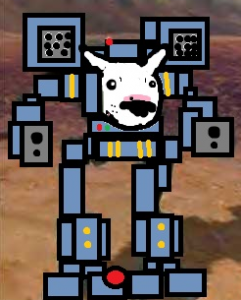 Most people reading this blog post will have an avatar. Many will have several. These include the images and characters we upload and create for our blogs, email profiles and on the social networking and game site we frequent. Avatars range from traditional photos (e.g. head shots) to custom images all the way to personalized animated characters. Many of the people we interact with on-line will only know us visually through our avatars.
Most people reading this blog post will have an avatar. Many will have several. These include the images and characters we upload and create for our blogs, email profiles and on the social networking and game site we frequent. Avatars range from traditional photos (e.g. head shots) to custom images all the way to personalized animated characters. Many of the people we interact with on-line will only know us visually through our avatars.
The avatars we select or create can impact how we think, feel and behave in cyberspace. The effects can be pronounced. For example, recent research at Penn State suggests that when we customize our avatars we impact our perceptions on the virtual environments we are in. More specifically:
“A group of students who saw that a backpack was attached to an avatar that they had created overestimated the heights of virtual hills, just as people in real life tend to overestimate heights and distances while carrying extra weight…”
This leads to the belief that you would have more difficulty climbing a virtual hill.
Students that were assigned an avatar with a backpack did not feel this way. This suggest we are really putting ourselves into our avatars (agency) as we customize and design them.
Bottom line for designers- tuning when and how people can customize their avatars may produce specific cognitive effects.

Posted in Cognitive Bias, Design | No Comments »
May 8th, 2013
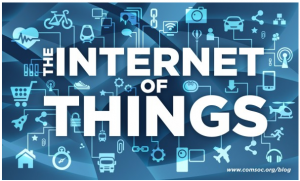 The internet of things is made up of our current computer-based internet plus a wide range of other devices that have a sensor and can send or receive information. These other devices include cameras, personal health monitoring devices, phones, cars, parking spaces, Christmas trees, appliances in your home, dog collars, power meters, traffic sensors, toys, fire alarms and many others. One estimate sees 24 billion devices on the internet of things by the year 2020. That’s more than 3 devices for every person on the planet.
The internet of things is made up of our current computer-based internet plus a wide range of other devices that have a sensor and can send or receive information. These other devices include cameras, personal health monitoring devices, phones, cars, parking spaces, Christmas trees, appliances in your home, dog collars, power meters, traffic sensors, toys, fire alarms and many others. One estimate sees 24 billion devices on the internet of things by the year 2020. That’s more than 3 devices for every person on the planet.
By connecting all of these things to the internet we enable direct machine to machine (M2M) interactions. That means one machine controlling or at least communicating with another via the internet. This will also create a river of big data the likes of which we have never seen and enable new services, marketing opportunities and even business models.
 Take for example, Budweiser’s Red Light. This device links to the internet via your WIFI and monitors the games of your favorite hockey teams. When a goal is scored it goes off. This enhances the experience of watching the game. A nice example of cognitive design- creating experience value and building brand. To quote:
Take for example, Budweiser’s Red Light. This device links to the internet via your WIFI and monitors the games of your favorite hockey teams. When a goal is scored it goes off. This enhances the experience of watching the game. A nice example of cognitive design- creating experience value and building brand. To quote:
“Our mission to get every Canadian closer to the game one goal at a time”
How can you build brand on the emerging internet of things? More generally, what new service and business opportunities does it present?
Internet of Things graphic: IEEE Communication Society Blog
Red Light image: The Classic Install

Posted in Related Fields, Service Innovation | No Comments »
May 1st, 2013
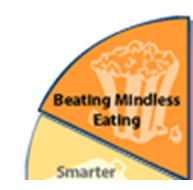 At Cornell University they have been investigating what type of small changes in eating habits produce lasting weight loss. Several years ago researchers ran a Mindless Eating Challenge involving 2000 participants to try and figure it out. They recently published an article that found:
At Cornell University they have been investigating what type of small changes in eating habits produce lasting weight loss. Several years ago researchers ran a Mindless Eating Challenge involving 2000 participants to try and figure it out. They recently published an article that found:
“The results of this study suggest that online interventions based on small changes have the potential to gradually lead to clinically significant weight loss, but high attrition from publicly available or “free” programs still remains a challenge.”
More specifically, 42% of the participants lost about one pound during the program. Approximately 7% of the participants saw a significant weight loss of 5% or more. Some gained weight. Impressive results when you realize how small the changes are. Examples that participants found most effective include:
- Don’t eat directly from a package, always eat from a dish
- Put down utensils between bites
- Keep food out of sight except for healthy items.
These types of changes are easy to make but not for everybody. As pointed out in a Science Daily blog post:
”Common barriers that prevented people from making changes included personally unsuitable tips, forgetting, being too busy, unusual circumstances such as vacations, and emotional eating.”
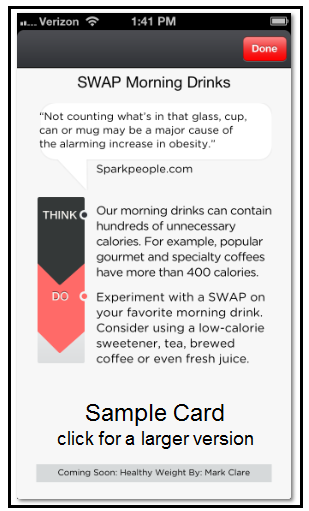 I am working with a physician to develop a solution that addresses most of these barriers. The solution is a deck of 24 knowledge cards that document the small changes you can make to achieve healthy weight loss.
I am working with a physician to develop a solution that addresses most of these barriers. The solution is a deck of 24 knowledge cards that document the small changes you can make to achieve healthy weight loss.
You use the cards through a free App called NewHabits. You can browse through the deck picking the cards that best fit your circumstances. That way the tips are always suitable. Because the cards are on your iPhone or iPad it is much easier to remember to use them. Cards are designed to fit everyday activities as well as special circumstances (e.g. vacations) and take just minutes to use. That way you can use them no matter where you are or how busy you might be.
Three sample healthy weight loss cards are available in NewHabits. One is shown above. Download the App (it is free), go to the store and look in the coming soon section for Healthy Weight cards. Give them a try and let me know what you think. We expect to publish the rest of the deck in June.

Posted in Behavior Change, Service Innovation | 4 Comments »
April 27th, 2013
 Innocentive has four open challenges that have a strong cognitive design component.
Innocentive has four open challenges that have a strong cognitive design component.
There is a call for a crowd-funded project to reduce tobacco consumption worldwide. P&G has requested proposals for disruptive new products in multiple categories. There is $2000 prize for the best idea on how to use data about the state of your house (from utilities, devices and sensors, etc.) to create useful and exciting consumer services. And another $2000 prize for figuring out how the PC should evolve in the next 3-5 years. Entries are due late in May.
Focusing on design concepts that are optimized for how our minds naturally work (as cognitive designers do) will lead to strong entries in each of these areas. I hope you are up for the challenge!

Posted in Events, Examples | No Comments »
April 23rd, 2013
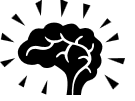 There can be little doubt that the race is on to improve how we innovate. Individuals, businesses, universities, economic regions and entire nations have a full on push to out innovate their competitors. New ways for making innovation faster, better and cheaper are sprouting up everywhere.
There can be little doubt that the race is on to improve how we innovate. Individuals, businesses, universities, economic regions and entire nations have a full on push to out innovate their competitors. New ways for making innovation faster, better and cheaper are sprouting up everywhere.
There is a lot of noise, some jewels and of course the fundamentals still hold true and dominate the game. One fundamental, often overlooked, is that innovation flows from specific skills and habits of mind. Innovators have a calling, think flexibly, experiment and are able to influence others to act on their ideas. These skills serve the innovator well even if they lack funding, organizational support or external incentives.
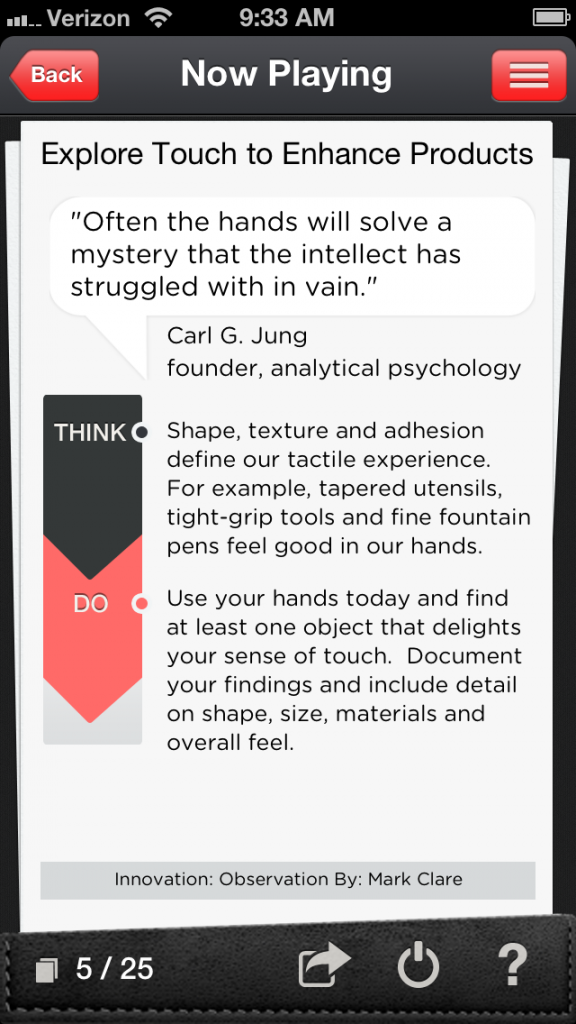 The best way to develop innovation skills is to practice them regularly until they become habits. Innovation is not a special technique or method, it is a habit of mind and way of viewing the world. For example, the knowledge card to the right provides a simple way you can practice a habit of highly effective innovators. Innovators engage the world in a robust way. One way they do that is by using all of their senses. Getting in the habit of using all of your senses in a way that opens up creativity is not hard but it does take practice. Try playing this card five or six times or until you have built up some good notes on products and services that really delight your sense of touch. Not only will you have new experience to draw on for thinking creatively about features and functions you should be well on your way to using your hands in a more robust way to know the world. A very good dividend for a modest amount of effort.
The best way to develop innovation skills is to practice them regularly until they become habits. Innovation is not a special technique or method, it is a habit of mind and way of viewing the world. For example, the knowledge card to the right provides a simple way you can practice a habit of highly effective innovators. Innovators engage the world in a robust way. One way they do that is by using all of their senses. Getting in the habit of using all of your senses in a way that opens up creativity is not hard but it does take practice. Try playing this card five or six times or until you have built up some good notes on products and services that really delight your sense of touch. Not only will you have new experience to draw on for thinking creatively about features and functions you should be well on your way to using your hands in a more robust way to know the world. A very good dividend for a modest amount of effort.
To scale this approach we will need many knowledge cards covering the core skills and habits of highly effective innovators.
Read the rest of this entry »

Posted in Behavior Change, Related Fields | No Comments »
April 18th, 2013
 Google released the specs for their new augmented reality glasses, called Glass, two days ago. The glasses come with a 5 mega pixel camera, contain 16 gigs of memory, send sound directly to you inner ear via vibration (no head phones or ear buds) and are synced with cloud storage, your phone and the web.
Google released the specs for their new augmented reality glasses, called Glass, two days ago. The glasses come with a 5 mega pixel camera, contain 16 gigs of memory, send sound directly to you inner ear via vibration (no head phones or ear buds) and are synced with cloud storage, your phone and the web.
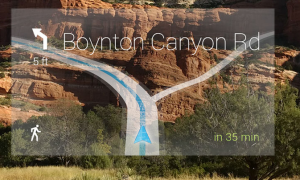 You speak to the glasses to take pictures, record video and send text messages. Even better you get information from the web that is projected into the transparent rectangle (mini-screen?) on the glasses about location, directions, flight times and facts (e.g. how long is the golden gate bridge). You can even do language translations. To see them in action from Google’s perspective check out How it Feels and from the users perspective these customer videos.
You speak to the glasses to take pictures, record video and send text messages. Even better you get information from the web that is projected into the transparent rectangle (mini-screen?) on the glasses about location, directions, flight times and facts (e.g. how long is the golden gate bridge). You can even do language translations. To see them in action from Google’s perspective check out How it Feels and from the users perspective these customer videos.
They appear to be very tough and come in a variety of colors including tangerine, charcoal, shale, cotton and sky. You can’t get a pair yet. They did an early release to 7000 explorers that paid $1500 each. They are slated to be in wide release later this year.
Google ventures has teamed up with several other venture capitalists to form the glass collective. The goal is to provide funding and accelerate the development of ”new experiences” based on the glass platform. A major opportunity for ambitious cognitive designers.
Source of images: Glass

Posted in Service Innovation | No Comments »
April 13th, 2013
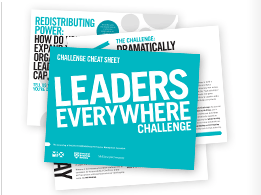 One way we democratize something is to make it available to a very large group, preferably everyone. Publishing your ideas on the Internet was democratized by blogging and trading stocks was democratized by on-line brokers. These functions, once held by highly trained experts are now open to anyone with a computer and Internet connection.
One way we democratize something is to make it available to a very large group, preferably everyone. Publishing your ideas on the Internet was democratized by blogging and trading stocks was democratized by on-line brokers. These functions, once held by highly trained experts are now open to anyone with a computer and Internet connection.
Now attention is turning to the democratization of leadership. Scholars have long recognized two general types of leaders. We have the formal or assigned leader such as the CEO or VP that carries the title, power and budget of leadership. But we also have the informal or emergent leader that wields influence and is driven by passion to change how things work. The question is, how do we develop and unleash these informal or emergent leaders?
If you have a good answer, you might want to submit it as a story or hack (disruptive idea) to the Leadership Everywhere Challenge. This is the latest M-prize being sponsored by the Harvard Business Review and McKinsey Consulting. A snapshot:
“In the future, a company that strives to build a leadership advantage will need an organizational model that gives everyone the chance to lead if they’re capable; and a talent development model that helps everyone to become capable.”
 In my teaching at Northwestern University I have been fortunate enough to work with emergent leaders from across the US. They are driven to lead without formal authority because they have an authentic insight into how to make things better and the natural influence skills to get others to act on their ideas. The skills and habits that make up informal leadership talent are developed very differently from those of formal leaders. They are developed through a micro or day-to-day learning from experience rather than elaborate and macro leadership development programs.
In my teaching at Northwestern University I have been fortunate enough to work with emergent leaders from across the US. They are driven to lead without formal authority because they have an authentic insight into how to make things better and the natural influence skills to get others to act on their ideas. The skills and habits that make up informal leadership talent are developed very differently from those of formal leaders. They are developed through a micro or day-to-day learning from experience rather than elaborate and macro leadership development programs.
I’ve captured this micro approach to developing emergent leaders in a free mobile learning app called NewHabits. Check out the modules or decks on innovation. They teach you how to find a cause, think flexibly, experiment and get others to act on your ideas. While the modules are focused on innovation these are just the skills and habits that drive emergent leaders. Best of all they can be practiced daily without formal authority, a training budget or the need to change your organization.
A good way to democratize leadership? Give the App a try and let me know what you think.

Posted in Events, Related Fields | No Comments »
April 8th, 2013
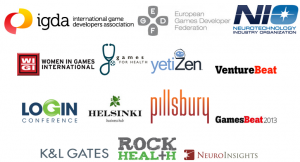 The NeuroGaming Conference and Expo runs May 1-3, 2013 in San Francisco. In neurogames technology is used to more directly link game play to your brain, nervous system and body. Examples include touch stimulation, augmented reality and gesture-based interfaces, brain-controlled games, emotional dynamics and even the direct electrical stimulation of the brain to improve performance.
The NeuroGaming Conference and Expo runs May 1-3, 2013 in San Francisco. In neurogames technology is used to more directly link game play to your brain, nervous system and body. Examples include touch stimulation, augmented reality and gesture-based interfaces, brain-controlled games, emotional dynamics and even the direct electrical stimulation of the brain to improve performance.
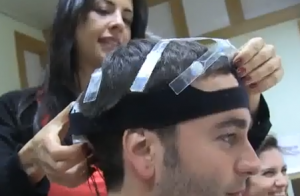 The conference will cover games, therapeutic games, investing and trends. In addition, eye tracking, brain monitoring and others tools that provide a robust but cost effective way of measuring mental states are covered. For example, Advanced Brain Monitoring will be at the conference. They offer a wireless medical grade EEG monitoring unit (shown directly above) that should be useful for all sorts of cognitive design studies. Check out a short video on how it is being used to help uncover the neuro-correlates of strong leadership.
The conference will cover games, therapeutic games, investing and trends. In addition, eye tracking, brain monitoring and others tools that provide a robust but cost effective way of measuring mental states are covered. For example, Advanced Brain Monitoring will be at the conference. They offer a wireless medical grade EEG monitoring unit (shown directly above) that should be useful for all sorts of cognitive design studies. Check out a short video on how it is being used to help uncover the neuro-correlates of strong leadership.
Best of all you can directly experience the games and tools on the expo floor.
I hope readers that attend the conference will share their impressions and photos. I am especially interested to hear if you believe neurogames offer a 10x improvement in the gaming experience.

Posted in Brain-Computer Interface, Events, Neuroergonomics, Related Fields | 8 Comments »
April 2nd, 2013
 For the last several months I have been collaborating with Jason Becker a former student and now COO of RICS software and co-founder of remember.com on developing an App for using and publishing decks of knowledge cards. We just launched NewHabits in Apple’s App store!
For the last several months I have been collaborating with Jason Becker a former student and now COO of RICS software and co-founder of remember.com on developing an App for using and publishing decks of knowledge cards. We just launched NewHabits in Apple’s App store!
NewHabits runs on a micro-learning technique and delivers flash cards for behavior change on a wide variety of life, business and social challenges. The decks are designed to make learning new skills and habits from experience much easier than other techniques. There are 7 decks in the NewHabits store now, 2 are free and there are 6 more in the pipeline. These are just seed decks. Many more are possible. We are actively recruiting new authors and offer royalties and free training and support on how to write decks. Check out the news release for more details.
If you don’t have an iPhone or iPad you can still get a detailed look at the App in this screen walkthrough. I am very interested in hearing from readers with ideas on how to improve the App, use existing decks to meet specific challenges (e.g. organizational change and innovation) or that are interested in authoring new decks. Knowledge cards are good for forging new personal habits, influencing group change and improving training and coaching. Please contact me directly at mark.k.clare@gmail.com or 260-433-7923.

Posted in Behavior Change, Service Innovation | No Comments »
 The Global Women’s Leadership Network has joined forces with others to launch a major effort in developing women and girl leaders around the world. They posted an open innovation challenge and are looking for fresh thinking on how to quickly build leadership capacity in women and girls. Their stretch goal is to develop 5 million women change agents improving our world in 5 years.
The Global Women’s Leadership Network has joined forces with others to launch a major effort in developing women and girl leaders around the world. They posted an open innovation challenge and are looking for fresh thinking on how to quickly build leadership capacity in women and girls. Their stretch goal is to develop 5 million women change agents improving our world in 5 years.












